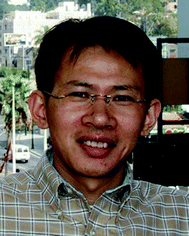Introduction to biomimetic therapeutics
Yongzhuo
Huang
*a and
Jianqing
Gao
*bc
aState Key Laboratory of Drug Research, Shanghai Institute of Materia Medica, Chinese Academy of Sciences, P.R. China. E-mail: yzhuang@simm.ac.cn
bCollege of Pharmaceutical Sciences, Zhejiang University, P.R. China. E-mail: gaojianqing@zju.edu.cn
cDr Li Dak Sum & Yip Yio Chin Center for Stem Cell and Regenerative Medicine, Zhejiang University, P.R. China
 Yongzhuo Huang |
 Jianqing Gao |
With the significant advances in physiology and pathology, better understanding of the in vivo dynamics of drug delivery provides a useful theoretical basis for the rational design of therapeutic strategies. Complicated bio-barriers are the primary challenge against effective pharmacotherapy. Advanced drug delivery techniques have been applied in pharmacotherapy to improve treatment outcomes and reduce adverse effects, and have already achieved promising progress. An ideal therapeutic system should be able to simultaneously meet different needs for overcoming various delivery barriers to achieve optimal drug distribution at the target organs, while minimizing unwanted exposure to normal organs. However, the delivery challenge includes multiple levels of bio-barriers (e.g., tissue, cell, and organelle levels). To address these barriers, a multifunctional and complicated system is usually designed, which, however, is usually related to a highly engineered fabrication process. Recently, biomimetic design has attracted significant attention. Biomimetics is a methodology based on imitation of systems and elements of nature to solve complex problems. Natural species have developed elegant yet straightforward mechanisms or features to resolve nature's numerous challenges, through millions of years of evolution through adaptation and survival of the fittest. Therefore, biological systems provide an excellent library for humans, from which we can learn a solution to a complex task yet with a simplified design. Biomimetic therapeutics (BTs) have become a state-of-the-art area in medical science.
The human body contains a highly complicated yet elegant transportation system for the delivery of nutrients. For example, serum albumin is an essential carrier for various bioactive molecules with hydrophobic nature (e.g., lipophilic hormones and fatty acids), transferrin carries iron, and red blood cells (RBC) carry oxygen. More importantly, pathological tissues and cells usually overexpress nutrient transporters to increase the uptake of nutrients to support rapid growth and proliferation. Via biomimetic application of these endogenous carriers and transportation mechanisms, BTs are not only able to improve the biodistribution of therapeutics and their intracellular fate, but also themselves can serve as active components to synergize the treatment.
As a case in point, endogenous compounds (e.g., albumin) and cells (e.g., red blood cells, RBC) have been widely investigated for use as BTs. Both albumin and RBC are known for their prolonged life span in circulation and thus ideally serve as drug carriers to extend drug half-life. For example, a hitchhike strategy has been often used to non-covalently attach peptides, proteins, and nanoparticles to endogenous albumin or RBC that serve as a “taxi” for prolonged drug delivery.1–3 So far, albumin-based delivery is arguably the most successful strategy of BTs, and there are several marketed drugs including liraglutide, albiglutide, semaglutide, and Abraxane. Other endogenous proteins like lipoproteins have also been widely used for targeted delivery. In Profs. X. L. Gao and G. Jiang's review of biomimetic drug delivery for brain diseases [DOI: 10.1039/C9BM01395D], lipoproteins play an important role in brain delivery.
Cell-based biomimetic delivery is another interesting case for BTs. For instance, RBC as living cell carriers have been investigated for decades, dating back to the 1970s.4 A major challenge for the process is how to encapsulate drugs, especially macromolecules, into RBC. Physical methods such as microinjection, electroporation, and hypotonic dialysis have been widely used. However, physical methods could involve disruption of the cell membrane and alteration in cell morphology and functions, and later on, biological methods were explored, like cell-penetrating peptide (CPP)-mediated drug loading.5 Interestingly, the living RBC biomimetic strategy has further developed into the RBC membrane-camouflaged method,6 representing a breakthrough in the biomimetic delivery field. With a similar design, membranes derived from various cells including cancer cells, macrophages, neutrophils, and platelets have been investigated as coating materials to prepare BTs; the easy availability and accessibility of different kinds of cell-derived membrane including exosomes offer a great possibility for drug delivery and therapeutic application. Prof. J. Q. Gao once summarized the targeted-delivery strategies in cancer gene therapy with mesenchymal stem cells.7 In this issue, Prof. X. Sun provided a review on biomimetic cell-derived nanocarriers for immune modulation [DOI:10.1039/C9BM01444F]. In addition, Profs. Sukhorukov & Zyuzin and Profs. Y. Z. Huang & X. Y. Sun, respectively, contributed two studies on mesenchymal stem cell-based drug delivery [DOI: 10.1039/C9BM00926D and DOI:10.1039/C9BM01401B]. Profs. M. Feng and C. F. Wang applied engineered microglia for imaging-guided surgery in glioma in their present work [DOI: 10.1039/C9BM01388A].
A pathogen is an organism with the ability to breach bio-barriers in the human body. Therefore, learning from pathogens provides an avenue for biomimetic design of drug delivery strategies. Virus- or bacteria-mimic systems have been studied. Prof. J. Q. Gao summarized virus-derived materials for various biomedical applications [DOI: 10.1039/C9BM01383K]. Moreover, Profs. P. C. Zhang & Y. P. Li specifically described recent progress in supramolecular peptide assemblies as virus mimics for cancer immunotherapy [DOI: 10.1039/C9BM01380F]. The lack of highly efficient delivery methods is a formidable challenge in gene therapy. Prof. Steinmetz developed a plant viral siRNA delivery platform using self-assembling cowpea chlorotic mottle virus with an efficient gene knockdown [DOI: 10.1039/C9BM00785G]. In addition, Profs. J. X. Zhang, S. X. Luo, and S. Chen gave a detailed account of bacteria-derived biomimetic systems in a comprehensive review on bioinspired strategies for oral delivery [DOI: 10.1039/C9BM01378D].
The understanding of pathogen biology not only helps develop biomimetic delivery strategies for overcoming bio-barriers, but also benefits biomimetic material design for combating bacteria. Prof. Brown summarized biomimetic antimicrobial materials for controlling drug-resistant bacteria [DOI: 10.1039/C9BM01393H].
Similarly, understanding of the physiological mechanism of glucose regulation promotes smart insulin administration. Profs. J. Q. Wang and Z. Gu reported a bioinspired glucose-responsive insulin delivery method via a forskolin-conjugated insulin analog targeting endogenous glucose-transporter [DOI: 10.1039/C9BM01283D]. Another biomimetic application of a physiological mechanism in this themed issue is proteoglycan/protein complexation. The sulfated residual of glycosaminoglycan chains of proteoglycans can complex with growth factors and form nanoscale organization in native tissues; based on this, Profs. Annabi & Simchi developed a biomimetic proteoglycan nanoparticle system for growth factor immobilization and delivery [DOI: 10.1039/C9BM00668K].
Last but not least, there are four interesting works on bioinspired nanomaterials. Profs. Y. K. Oh and G. Shim developed a biomimetic polymeric system co-loaded with a photosensitizer and an immune stimulant for photodynamic immunotherapy to inhibit both primary and metastatic tumors [DOI: 10.1039/C9BM01704F]. Prof. Alvarez-Lorenzo reported cytosine-functionalized bioinspired hydrogels as contact lens materials for the delivery of transferulic acid [DOI: 10.1039/C9BM01582E]. Prof. H. J. Lee developed antigen-coding mRNA and adjuvant coloaded lipid-based nanoparticles as a cancer therapeutic vaccine [DOI: 10.1039/C9BM01564G]. Prof. W. J. Kim designed a polymeric phenylboronic acid–tannic acid nanogel as an efficient anti-inflammatory agent [DOI: 10.1039/C9BM01384A].
This themed issue on “Biomimetic therapeutics” presents many latest advances in biomimetic delivery and therapy, and offers an overview of various cutting-edge theranostics strategies. We believe this issue will offer some exciting insight into the field.
Acknowledgements
We would like to express our gratitude to all the contributors to this issue as well as the reviewers for their input. At the time of this Editorial being published online, there are several works still in the peer review process. We are excited that this web collection will continue to grow as more valuable contributions are added to the collection following peer review.References
- A. Angelini, J. Morales-Sanfrutos, P. Diderich, S. Chen and C. Heinis, J. Med. Chem., 2012, 55, 10187–10197 CrossRef CAS PubMed.
- Y. Chang, S. Yao, Y. Chen, J. Huang, A. Wu, M. Zhang, F. Xu, F. Li and Y. Huang, Nanoscale, 2019, 11, 611–621 RSC.
- A. C. Anselmo, V. Gupta, B. J. Zern, D. Pan, M. Zakrewsky, V. Muzykantov and S. Mitragotri, ACS Nano, 2013, 7, 11129–11137 CrossRef CAS PubMed.
- R. A. Schlegel and M. C. Rechsteiner, Cell, 1975, 5, 371–379 CrossRef CAS PubMed.
- Y. M. Kwon, H. S. Chung, C. Moon, J. Yockman, Y. J. Park, S. D. Gitlin, A. E. David and V. C. Yang, J. Controlled Release, 2009, 139, 182–189 CrossRef CAS PubMed.
- C. M. Hu, L. Zhang, S. Aryal, C. Cheung, R. H. Fang and L. Zhang, Proc. Natl. Acad. Sci. U. S. A., 2011, 108, 10980–10985 CrossRef CAS PubMed.
- Y. L. Hu, Y. H. Fu, Y. Tabata and J. Q. Gao, J. Controlled Release, 2010, 147, 154–162 CrossRef CAS PubMed.
| This journal is © The Royal Society of Chemistry 2020 |
